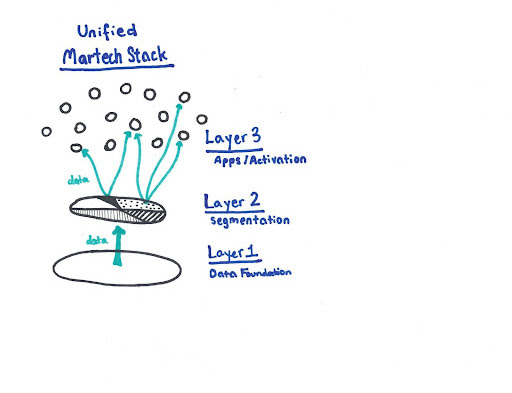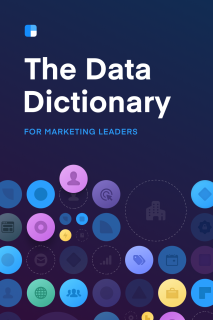Chapter 6
10 minutes
Setting up your martech stack and activating your ICP
Focusing on prospects who fit your ICP and demonstrate high intent isn’t just good business sense — it’s critical to growing revenue efficiently in any market environment. When all your marketing tools work together to focus your dollars and resources on your ICP, they create coherent experiences for your ideal prospects across all your channels — and increase conversion rates.
At Clearbit, we call this activating your ICP, and it starts with a strong data foundation and best-in-class marketing tools. Let’s take a look at how data flows through your martech stack. Then, we’ll show you how to operationalize your ICP with data to create an ideal prospect definition your tools can focus on.
Getting your data house in order: Enriching your source of truth and putting data on tap
The first step to focusing your GTM efforts on your ICP is to enrich your company’s source of truth — like your CRM, MAP, or CDP — with fit and intent data from multiple sources. A rich combination of data gives you a foundation to identify and segment your ICP audience, score and route leads correctly, and personalize the buyer’s journey.
And it needs to be fresh and accurate: B2B data decays quickly due to job turnover and company growth. When your data is stale or inconsistent, it’s impossible to deliver the right experiences to the right prospects at the right time. Clearbit automatically refreshes records as soon as a change is detected, for over 100 company and employee attributes.
A free flow of data is important: Information needs to travel between your CRM, MAP, and CDP, as well as all other tools in your stack that touch your customers, each one updating the other. We call this ubiquitous information “data on tap.”
“Data in the martech stack has become more on tap than it used to be. And that opens up a lot of possibilities for real-time intelligence and real-time use and activation of data at many different apps and touchpoints. This philosophy changes how we think about data and where it might be used.”
Kevin Tate, CMO at Clearbit
Data on tap
In the early aughts, if you wanted to jam out to the latest Christina Aguilera album, you had to store that music somewhere: on a CD, iPod, or hard drive. But today, with services like Spotify, music flows freely to any device with the push of a button.
Data is going through a similar transformation. Increasingly, marketers design their martech stacks to create data on tap — a free flow of fresh data, accessible anywhere.
Our CMO at Clearbit, Kevin Tate, points out that data on tap enables better alignment and collaboration across sales, marketing, customer success, and operations. Kevin says, “Without reliable, fresh, and complete data across all functions, it’s hard to have a common language and signals to test hypotheses that cross silos.”
Putting data on tap into practice
For example, Segment incorporates Clearbit data into their foundation by enriching all records in Salesforce. A new lead is populated with firmographic and employee information — job title, phone number, location, etc. — which lets reps save time on research. Enriched data also flows into other tools like Zendesk and predictive lead scoring apps.
With Clearbit, getting customer data into business-critical systems isn’t an engineering roadblock anymore. Just turn on the tap.
Tools of the trade: The three layers of your martech stack
A best-in-class martech stack can be organized into three layers.

1. Data foundation
Your data foundation is one central platform or union of platforms that combines and refines data for (and from) all parts of the business, including:
- Your data from your CRM, MAP, and/or CDP
- Third-party firmographic and technographic data enrichment
- Intent data from website activity
- Any other sources that matter to your GTM
By combining first- and third-party data from many sources, your data foundation closes any gaps in different data types and creates a well-rounded picture of your customers, leads, and unengaged potential customers in your broader TAM.
One example is Clearbit’s Data Activation Platform, which acts as the Grand Central Station of a go-to-market engine. The platform takes in information about leads and customers from your databases, as well as engagement data from activity on your website. It automatically enriches records with B2B attributes, and offers a full view of the market so you’re not limited to known leads.
With this enhanced view, you can design audiences to send to your marketing and sales tools from Clearbit.
2. Segmentation and audience-building layer
The second layer of your martech stack gives you the capability to define segments in your TAM and generate marketing audiences.
For example, you can plug in your ICP criteria to pull a list of your ICP customers and prospects, and select which companies and employees will see a marketing campaign.
Let’s say you’re running Facebook awareness ads for your product design tool for B2B SaaS companies, and you want to target high-level leadership, like managers and directors. You have different messaging for product teams and design teams. You also have different messaging for SMBs versus midmarket-sized companies. In addition, you’re only operating in the US, so you want to weed out companies in other countries so you don’t waste advertising budget on them.
Your segmentation criteria might look something like this:
| Company size👉 Team type 👇 |
SMB | Midmarket |
|
|
|
|
|
|
In this example, you can see how easy it is to isolate the ideal companies for your campaign, and then divide them into four smaller segments for more targeted ads.
Another key segmentation layer is intent. In addition to generating awareness, you may be running retargeting campaigns to move buyers down the funnel. Here you will also want to layer in intent to create ads tailored to specific webpages that have been viewed. Your segmentation may look something like this:
| Company size👉 Team type 👇 |
SMB | Midmarket |
|
|
|
|
|
|
Because the tools in this layer sit on top of your data foundation, you’re creating audiences based on fit and intent data in real time — which means those audiences are dynamic. As people get promoted to Manager, they enter your audience; as they leave for another company, they exit your audience. As a company grows from 100 employees to 120, they move from one segment to another.
Once you’ve defined your audience segments, they should easily flow into other tools and data layer platforms, such as back into your CDP, or out into your email marketing tool and Facebook advertising.
This can be done in Clearbit’s Data Activation Platform via Clearbit Audiences.
3. Activation layer
The activation layer consists of all the many marketing and sales tools you use that touch the customer. These apps put your data to work.
After you define audiences in your segmentation layer, you send them to tools in your activation layer. For example:
- Email marketing platform
- Website personalization platform like Mutiny, Optimizely, VWO, etc.
- On-site chat platform like Intercom or Drift
- Facebook and Instagram advertising
- Google advertising
Today, SaaS companies are trending toward using more and more highly specialized apps in their marketing stack, and this is often most apparent in the activation layer — for example, rather than using one platform as a CRM, email tool, and ad tool, companies use many different apps to achieve one specific goal or create one touchpoint.
Having so many activation apps could get unwieldy, but when they are layered over a data foundation (Layer 1) and a segmentation layer (Layer 2), they can act in a united way — reaching the same ICP prospects with coordinated, consistent messaging across touchpoints.
“Using tools that are best in class, you can improve your data quality 5% - 10%, which means the data you’re serving up in your ads, emails, and to your sales teams is that much better. We are constantly evaluating tools and techniques to improve our own internal data so our processes are smoother, conversations are more personalized, and our ads get to the right people.”
Julie Beynon, Head of Analytics at Clearbit
Operationalize your ICP
To make Layer 2 segmentation work, you need a shared ICP definition around which your company can align its GTM operations. But far too often, teams spend weeks (if not months) describing their ICP, only for it to live on a slide, becoming outdated by the minute.
Instead, your ICP definition needs to be data-driven. An operationalized ICP allows you to:
- Prioritize ICP leads and accounts for efficient growth using firmographic, technographic, and employee data points.
- Measure success against your ICP definition (e.g., did an ad campaign drive many leads but very few ICP leads?).
- Analyze and refine your ICP on an ongoing basis (e.g., programmatically updating your ICP as your company expands into a new market).
Here's an overview of the steps to operationalize your ICP.
Step 1: Build the data foundation
Enrich your source of truth (CRM software, CDP software, etc.) with accurate and fresh data. To accurately define your ICP, you’ll want to make sure you have complete firmographic and technographic data (like company size, technologies used, industry, etc.) for accounts in your database.
Step 2: Define success criteria
First, choose metrics that describe your best customers, taking into account your business’s current goals. For example, if your company is oriented toward growing revenue at all costs, your success metrics might be customers with high ACV, low CPA, and ease of conversion. However, if your business is prioritizing sustainability and customer retention, your metrics might be high LTV, low churn risk, or cross-sell potential.
Step 3: Look at the past and identify your best customers
Pull a shortlist of customers who meet your success criteria, using historical revenue data and qualitative feedback from CS and sales.
Step 4: Analyze for shared traits
Identify shared firmographic and technographic attributes these customers have, such as industry or number of employees.
Step 5: Create a sillouhette of your ICP
List out the attributes that will best predict whether a new prospect will be a good customer — a data sketch. For example: “B2B SaaS companies that use Hubspot, have 50–1,000 employees, and have at least $10 million in funding”.
In the next chapter, we’ll show you how Clearbit makes it easy to send your new ICP definition to your go-to-market tools, channels, and motions.

